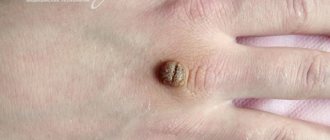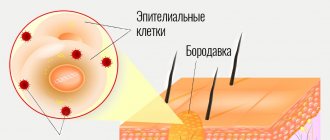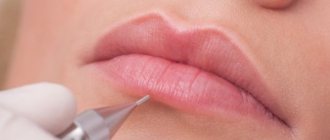WHAT WORRIES YOU? PAIN during intercourse HOW TO GET YOUR VIRGINITY BACK YOU DO NOT like the labia CYSTITIS after sex DARK perineum SIZE of the vagina INTIMATE life after childbirth LACK OF ORGASM WHAT IS YOUR INTEREST? Plastic surgery of the labia Restoration of virginity Surgical defloration Vaginal reduction Clitoral plastic surgery Intimate muscle training How to achieve orgasm HOW TO DO IT? Get intimate plastic surgery... Get contour plastic surgery... Intimate cosmetology... Take tests for a fee... See a gynecologist
In addition to being concerned about the appearance of their genitals, many women experience soreness or other problems related to the health of their labia. Inflammation, pain, swollen or irritated tissue and itching are common problems in this intimate area. Additional complaints include stretching after childbirth, pimples, increased thickness, and unusual or tender lumps on the inner surface of the labia minora.
The female reproductive system is divided into external and internal. When a process occurs in one organ, there is a risk of it occurring in the other. Infections often begin in the folds of skin of the external genitalia, primarily because they are moist due to their proximity to the urethra and vagina. For many women, the initial symptoms of genital diseases, especially itching, burning, swelling, discomfort, begin with minor irritation and can then progress and spread to the rest of the vulva and vagina.
Other symptoms that may occur with inflammation of the labia may include pain in the lower abdomen, burning when urinating, and increased vaginal discharge. They are usually thick, yellow, green, and have a persistent unusual odor. The most common causes of vulvar and vaginal discomfort are thrush and bacterial vaginosis, and these can be successfully treated with medication. Sexually transmitted diseases are a concern both in terms of correct diagnosis and rational, effective treatment.
Inflammation of the labia minora and majora can often be accompanied by the formation of erosions and ulcers on their surface. As a result of scratching, the ulcers can merge and form confluent erosive surfaces that are prone to bleeding. Ulcers are most often the result of the spread of a virus or infection that leads to inflammation. Itching of the external genitalia in women is present in almost any type of infectious process. Inflammation of the labia is almost always accompanied by itching, which aggravates the severity of the process. The fact is that constant trauma when scratching an intimate area contributes to the spread of the inflammatory infiltrate and an increase in the number of ulcers. The addition of secondary microbial flora is also possible.
But inflammation of the genital organs is not always a consequence of infection. It may be a manifestation of an allergic reaction to the substance. Most often these are remnants of washing powder, lubricant on a condom or intimate hygiene gel. Sometimes inflammation can be a response to lack of hygiene in partners. This fact must also be taken into account during intimacy.
Inflammation of the labia may be a consequence of recent hypothermia (for example, after a swimming pool or simply in cold weather). As a result, dense formations the size of a pea are palpated in the area of the external genitalia - this is an inflamed lymph node.
Why do the labia become swollen after sex?
Some girls are frightened by the situation when, after sex, the labia is swollen - one or two at once. In fact, nothing terrible happened, because they are equipped with a large number of venous and arterial vessels and nerve endings. Since one of the erogenous zones of the female body is located in this place, any caress or simple touch causes swelling of the lips of the genital area. The quantitative increase in their size depends on the individual characteristics of the body and the level of hormonal levels. By the way, according to the observations of gynecologists and reviews from the patients themselves, rubbing, itching and swelling occur in girls and women who have enlarged, stretched labia of complex shape.
If the change in the size of the labia, their swelling and the desire to scratch them lightly are associated only with intimate contact, then there is no need to worry. But if swelling does not go away after 8-10 hours after sexual intercourse, you should think about visiting a gynecologist, as the cause may be a disease.
If any discomfort occurs in the intimate area, including when the labia minora are swollen, it is worth determining the cause and a good gynecologist will help with this. Reception of a specialist in our clinic daily, from 10-00; pre-registration by phone 8(495)761-1085 or online on the website.
The inflammatory process of the external genital organs (vulva) in gynecology is called vulvitis
Among the most common causes of vulvitis are sexually transmitted infections, constant stress, tuberculosis or E. coli and other microorganisms. The allergic factor also plays an important role. That is, vulvitis can be the result of an allergic reaction of the vulvar mucosa to a certain irritant: household chemicals, pads, wet and dry wipes, toilet paper, synthetic underwear, condom lubricant, vaginal suppositories, douching, etc.
It is characteristic that allergic vulvitis can occur not only in adult women, but also in children's girls.
Allergic vulvitis in a woman
In women, as a rule, allergic vulvitis is secondary and is associated with exacerbation of diseases of the genitourinary system (for example, colpitis, vaginitis, cervicitis, etc.). If allergic inflammation is still primary in nature, then it is associated with a hypersensitivity reaction to a chemical irritant. This leads to the production of inflammatory mediators and the appearance of characteristic symptoms.
Vulvitis in women is accompanied by the following symptoms:
- itching and burning in the intimate area (clitoris, labia, vaginal opening - cause maximum discomfort during movement, urination, sexual intercourse;
- hyperemia of the vulvar mucosa, as well as the formation of edema;
- the formation of pustules and ulcers as a result of scratching the delicate skin of the vulva;
- the perineum, depending on the severity of the disease, is covered with a white film from the clitoris to the anus.
If you experience these symptoms, immediately contact a medical professional for a diagnosis and appropriate treatment.
Swelling of the penis and testicles.
Swelling of the genital organs can be caused by both completely harmless factors (passionate sex, tight underwear, allergies, poor hygiene) and serious reasons. Therefore, if the swelling does not subside within a day or additional symptoms appear (itching, burning, redness, discharge, rash, inability to open the foreskin), you should consult a specialist.
Why does the penis and/or testicles swell?
Various reasons can cause swelling of the penis and testicles:
Balanitis, posthitis, balanoposthitis.
Balanitis (inflammatory disease of the head of the penis) and posthitis (inflammatory process of the foreskin) are usually inseparable, which is why they are combined under the common term “balanoposthitis.” In a man, erosions form on the head of the penis and in the area of the foreskin, pain, swelling, and hardening of the inguinal lymph nodes are possible.
Cavernite.
Pathological processes in the cavernous bodies cause swelling of the shaft of the penis.
Phimosis.
Due to the narrowing of the foreskin, the head of the penis is not fully released, which leads to inflammation and swelling.
Paraphimosis.
Pinching the head of the penis by the foreskin causes redness and swelling of the organ, and pain when urinating. In the absence of timely medical care, tissue necrosis is possible.
Thrombophlebitis.
As a result of inflammation of the dorsal vein, the penis swells and the temperature rises sharply. Physical activity and movement cause pain.
Allergy.
Itching and swelling of the penis can be caused by synthetic underwear, poor-quality lubricants, condoms, and long-term use of antibiotics.
Microtraumas.
The slightest bruise can provoke swelling of the penis and the appearance of a hematoma, which is explained by the increased sensitivity of the organ. Sometimes the cause of microtrauma can be a strong impact on the penis during sexual intercourse or masturbation, or wearing too tight underwear.
Infections.
Sexually transmitted diseases (trichomoniasis, chlamydia, gonorrhea, syphilis) often cause swelling of the genital organs. With syphilis, a growing compaction also becomes noticeable, and the general condition worsens. Swelling of the penis is also possible with systemic infections (tuberculosis).
Tumor.
The cause of swelling can be a malignant neoplasm, but swelling of the entire trunk is extremely rare.
Allergic vulvitis in children
In girls, up to newborns, vulvitis is primary in nature and is the result of an allergic reaction of the mucous membrane of the external genitalia to a particular allergen. Allergic vulvitis in a child can be triggered by the most basic things: failure to comply with the rules of genital hygiene, synthetic fabrics, diapers, baby powder, poor-quality personal hygiene products, the presence of diseases or parasites in the body (helminthic infestation, dermatitis, weakened immunity, diathesis, endocrine disorders and etc.).
As for the clinical picture of vulvitis in girls, it is similar to the manifestations in a mature woman: cheesy discharge, inflammation of the vulvar mucosa, burning sensation when urinating and walking. The child may also have a fever.
Treatment of allergic vulvitis
Therapy for allergic vulvitis has a similar scheme to the treatment of infectious inflammation of the external organs of the reproductive system, with the exception of antibacterial drugs. It is advisable to use local anti-inflammatory ointments and creams, herbal sitz baths, immunomodulators and vitamins.
However, the treatment of the allergic form of vulvitis has certain features . So, first of all, it is necessary to identify the allergen - the factor that caused inflammation of the vulvar mucosa. The doctor is able to identify possible allergens by the spread of the inflammatory process. For example, if vulvitis is localized on the labia majora, then the cause is most likely the material that comes into contact with the external genitalia (pads, diapers, underwear, personal hygiene products, etc.). If the inflammatory process has affected the entrance to the vagina, then you should pay attention to condoms, lubricants and intimate hygiene products.
Having determined the possible range of provoking factors, the doctor will recommend antihistamines and personal hygiene rules. In addition, you should review your diet and avoid foods that are among the most common allergens. After this, depending on the degree of progression of the disease, the gynecologist will prescribe general restorative therapy: vitamins and immunostimulants.
Make an appointment with a gynecologist
Newspaper "News of Medicine and Pharmacy" 15 (425) 2012
Quite rare and poorly diagnosed diseases in allergology and urology include allergic diseases of the genital organs (AZPO), or genital allergies [15], which includes a variety of clinical manifestations of allergic reactions in the genital area. Allergic reactions from the skin and mucous membrane of the genital organs can develop through direct contact with allergens or when the latter enter the body orally or parenterally. At the same time, allergic reactions, according to the classification of PGH Gell and PRA Coombs (1964), can develop according to immediate, immunocomplex, delayed or mixed types, which further complicates the timely diagnosis of this group of allergic diseases [15]. There is very little data in the available literature on the actual prevalence of ADPO, but even a few publications indicate their sufficient frequency. Unfortunately, patients with ADPO are often treated for a long time by a gynecologist, urologist, or dermatologist, which contributes to the aggravation of the course of allergopathology, its chronicity, the development of complications, etc.
Currently, there is no generally accepted classification of AZPO, and therefore various options are proposed. Thus, S. Sonnex [15] subdivides AZPO into those related to and not related to sexual contacts. He includes seminal fluid, spermicides, latex, lubricants, cosmetics, body lotions, antiperspirants, especially those containing polyethylene glycol, topical and oral (penicillin and other antibiotics, benzoyl peroxide, vinblastine, thioridazine) drugs, including and those used by the sexual partner, a number of foods, the components of which enter the seminal fluid, physical activity for patients with physical urticaria, butyl nitrate. The author lists topical medications (ethylenediamine, framycetin, neomycin, clobetasol propionate, aminoglycosides, chlorocresol, lidocaine, benzocaine, miconazole, econazole, thioconazole, clotrimazole, benzyl alcohol, clindamycin, acyclovir) as causes of development of ADPO not related to sexual contacts. treatment of gynecological pathologies, feminine hygiene sprays, cosmetics and detergents for intimate hygiene, sanitary pads and napkins treated with acetylacetonate, cinnamyl alcohol or aldehyde, urine, allergens of Candida fungi. Most other authors [6, 9–11, 13] propose to classify AZPOs according to their localization, which is more convenient for practical use. In this regard, below we will provide data on the most common ADPOs in men and women, as well as latex and postcoital allergies, which can develop in both sexual partners.
The most common forms of ADPO in men include allergic contact balanoposthitis and balanitis, which respectively manifest themselves as damage to the glans penis and foreskin. When an allergen is exposed to the skin of the scrotum, perineum, and thighs, allergic lesions can be localized there too. These diseases are characterized by itching, burning, swelling and hyperemia of the skin and mucous membranes of the penis, skin rashes in the form of spots, blisters, and superficial erosions. In this case, swelling of the foreskin also often occurs, which leads to phimosis. Clinical symptoms develop after contact with an allergen, most often when using latex condoms (latex allergy), antiseptics, local contraceptives with spermicidal properties containing nonoxynol-9, benzocaine, hexylresorcinol, benzalkonium chloride, chloramine, quinine and aromatic additives. Cases of ADPO are less common in men with oral intake of medicinal allergens (sulfonamides, antibacterial drugs, vitamins, vaccines). The signs of balanoposthitis are quite varied and in many cases, in addition to pathological changes in the glans penis and foreskin, there are urethral symptoms, changes in peripheral lymph nodes, joint pathology, skin lesions in other parts of the body, and less commonly, symptoms of allergic rhinitis and conjunctivitis.
Fixed erythema of the glans penis is possible with oral or parenteral administration of certain medications. Previously, it was noted more often with the use of sulfonamides. Fixed erythema is characterized by the appearance of a persistent, painless spot with clear boundaries of a dark red color and, as a rule, disappears spontaneously over several weeks.
Inflammation of the urethral mucosa (allergic contact urethritis) can occur in both sexes. Its clinical picture is practically no different from urethritis of infectious etiology. The only difference between them may be the spontaneous disappearance of symptoms after stopping contact with the “culprit” allergen. The development of allergic contact urethritis is often associated with local (intraurethral) use of drugs for emergency prevention of infectious diseases of the genital organs. Clinical symptoms of urethritis are itching, burning, pain and stinging when urinating, as well as discharge from the urethra. Men often experience irritation, redness and sticking of the urethral sponges. These symptoms may be mild at the beginning, but if the disease is diagnosed late, the process may spread to other genital organs. At the same time, the symptoms of urethritis in men, due to anatomical features (longer and narrower urethra), are felt more acutely than in women.
The most common ADPO in women is allergic contact vulvitis (less commonly vulvovaginitis), characterized by damage to the female genital organs and vagina [13]. Typically, this disease occurs when using vaginal suppositories, creams, tablets for the treatment of infectious diseases of the female genital area or to prevent pregnancy [13]. Most often, allergic reactions are associated with the use of vaginal contraceptives containing nonoxynol-9, iodine preparations (polyvinylpyrrolidone iodine), as well as cosmetics, body lotions, antiperspirants, intimate hygiene products, especially those containing propylene glycol [7, 15]. Often, allergic vulvovaginitis occurs in conjunction with fungal (usually candidiasis) infection of the genital area. In the acute period of allergic contact vulvovaginitis, patients experience itching, burning, profuse discharge, redness and swelling of the labia minora and majora, pain after urination due to irritation of inflamed tissues by urine. The diagnosis is established on the basis of the patient’s complaints, changes in the vulva detected during examination, as well as negative results of bacteriological examination of vaginal discharge.
Recently, reports have increasingly been published about the increase in the frequency of latex allergies as a result of the widespread use of rubber products in medicine, in production and in everyday life. At the same time, groups at increased risk of developing latex allergy in the genital area include men and women who use latex contraceptives, as well as gynecological and urological patients. Spermicides included in their composition can also act as allergens when using condoms. Allergic reactions to latex proteins and other components of rubber products can occur in immediate and delayed types in the form of allergic contact balanitis, balanoposthitis, vulvitis, vulvovaginitis [15]. Most clinical manifestations (mainly type IV hypersensitivity reactions) of latex allergy are moderate and localized in the penis or vulva. Additional symptoms include itching, swelling of the skin, mucous membranes and subcutaneous tissue, as well as abdominal symptoms (spasm, nausea, vomiting, diarrhea), rarely anaphylactic shock. In this case, symptoms of latex allergy in sensitized people usually develop within 24–48 hours after contact with this allergen. Anaphylactic-type hypersensitivity reactions with the onset of these symptoms in a shorter period of time may occur much less frequently. Diagnosis of this type of ADPO is helped by data from an allergic history, positive results of a skin test for latex allergens, or the detection of specific IgE class antibodies in the blood serum. Women and men with hypersensitivity to latex allergens are recommended to use polyurethane condoms.
Sometimes patients of both sexes experience the occurrence of allergic vulvovaginitis and balanoposthitis immediately after sexual intercourse, which is called postcoital allergy [10]. It was first described in 1958 by Specken in a 65-year-old woman who experienced generalized urticaria and bronchospasm after sexual intercourse. Subsequently, quite a lot of reports were published [6, 8, 9, 11, 12, 14] about the occurrence of an allergic reaction to sperm, which is probably due to a general increase in the number of allergic diseases, including ADPO. Most often, postcoital allergies are recorded in women, however, it is likely that hypersensitivity to semen allergens can also occur in homosexuals. In the literature, the term Burning Semen Syndrome is also used to refer to an allergic reaction to sperm - a syndrome of “burning” sperm, manifested by a pronounced burning sensation in the vagina after seminal fluid enters it. According to Johnson Burstein from the University of Cincinnati in the USA, every eighth woman with allergy pathology suffers from postcoital allergies. And according to the observations of Canadian allergists, every third woman with pain in the genital area may have an allergic reaction to sperm allergens. Most often, postcoital allergy is observed in young women, although cases of its development in the postmenopausal period have also been described [15].
The supposed allergens for postcoital allergies are glycoproteins with a molecular weight of 12 to 75 thousand daltons, contained in the secretion of the prostate gland and seminal vesicles, which is mixed with sperm during sexual intercourse [10, 15]. This is also confirmed by the fact that vasectomy in a regular sexual partner does not lead to the disappearance of postcoital allergies. Factors contributing to its development include a burdened personal and family allergic history, including a “hereditary” form of sperm allergy (familial allergic seminal vulvovaginitis), since cases of vaginal sperm allergy in mothers and their daughters have been described [6, 10] . Other triggers include ligation of the fallopian tubes, removal of the uterus, the use of intrauterine devices, vaginal suppositories with spermicidal action, pregnancy, women’s use of intimate hygiene products, lubricants, the presence of viral, bacterial and fungal lesions of the genital area, etc. Thus, in women the most common The cause of postcoital allergy is a hypersensitive reaction to prostate antigens found in semen, and in men, a reaction to the acidic environment of the vagina. It should also be taken into account that in some cases, patients develop sensitization simultaneously to semen and latex allergens, often with the simultaneous development of immediate and delayed hypersensitivity [7, 8, 11].
Postcoital allergy occurs, as a rule, of the immediate type and is characterized by the development of hyperemia, burning, itching of the vulva, vagina and glans penis within a few minutes or hours after sexual intercourse [9]. The most common manifestations of this type of ADPO are burning and itching in the vagina, occurring within a few minutes to 24 hours after sexual intercourse and lasting up to 2–3 days [6]. Less common are signs of allergic vulvovaginitis with swelling of the labia minora and majora, the perianal area with severe burning and itching, the formation of vesicles, lichenification and the development of contact dermatitis of the vulva, generalized eczema [8, 9, 11]. Even less common are generalized forms of the disease in the form of urticaria, rhinitis, conjunctivitis, laryngeal edema, bronchospasm, fever, arthralgia, lower abdominal pain, vomiting, diarrhea, cerebrovascular accident, hypotension and anaphylactic shock [10, 15]. It should be noted that symptoms of postcoital allergy can appear both several months and many years after the start of sexual activity, as well as after the first sexual intercourse with one or different partners. In addition, the immunopathological processes underlying the development of postcoital allergy can subsequently cause infertility, since the antibodies produced in this process have a spermicidal effect.
Diagnosis of ADPO is based on anamnestic data, the results of a physical examination with mandatory consultations with a gynecologist and urologist, as well as on the results of skin tests (prick test, patch test) and laboratory research methods with suspected allergens [13] . When collecting anamnesis, it is necessary to take into account personal and family history of skin, allergic, gynecological and urological diseases, the influence of cosmetic, medicinal, contraceptive and intimate hygiene products, sprays, lubricants, antiperspirants, sexual intercourse, urological and gynecological manipulations on the occurrence of symptoms of genital allergy. When conducting a physical examination, in addition to diagnosing genital allergies, one should determine its prevalence and localization, find out the nature and causes of damage to the skin and mucous membranes of the genital organs, and the presence of signs of concomitant allergic diseases. However, the final diagnosis of ADPO should be established only after obtaining evidence of the relationship of clinical symptoms with causally significant allergens. For this purpose, patients undergo skin and laboratory testing with suspected allergens. If hypersensitive reactions of the anaphylactic type develop, a prick test with allergens is performed, and a radioallergosorbent test or enzyme-linked immunosorbent assay is selected from laboratory research methods. If delayed-type hypersensitivity predominates, an application or patch test with allergens and chemiluminescent analysis are indicated. Carrying out a patch test on mucous membranes showed less information in diagnosing ADPO than similar testing on the skin [15]. In addition, testing with allergens on the surface of the mucous membranes of the genital organs is technically more difficult to implement. The reactions of blast transformation of lymphocytes and inhibition of migration of leukocytes with the corresponding allergens have not lost their diagnostic value in delayed-type allergic reactions. In order to diagnose ADPO in women, it is possible to conduct a vulvar or vaginal provocation test with suspected allergens, followed by a colposcopic examination of the condition of the epithelium of the genital organs. Unfortunately, the difficulties of specific diagnosis of ADPO are largely due to the lack of a standard set of allergens for this pathology for skin and laboratory testing.
Diagnosis of latex and postcoital allergies has its own characteristics. Thus, the diagnosis of latex allergy is based on a number of mandatory and auxiliary studies. Mandatory methods include:
1. Collection of an allergic history (establishing a connection between the onset of the disease and its manifestations with the use of latex objects, work in the field of medicine or the rubber industry, frequent diagnostic and surgical interventions, heredity burdened with atopy, time of occurrence of reactions, their combination with other allergic diseases, development allergic reactions when consuming food products that can cause cross-allergic reactions with latex, etc.).
2. Examination by an allergist.
3. Skin testing: prick test with a latex allergen and/or patch test with a fragment of a latex glove.
4. Test for specific release of histamine from blood basophils.
Additional research methods include:
1. Bronchial and/or nasal provocation test with powder from latex gloves.
2. Determination of the level of total IgE.
3. Determination of the level of latex-specific IgE antibodies.
4. Study of external respiration function.
Based on allergy history data, the presence of latex allergy can be suspected with a high degree of certainty, but its specific diagnosis is carried out using in vivo and in vitro tests with a latex allergen. In vivo diagnostic tests include latex allergen skin testing. This diagnostic method is especially informative for latex allergies caused by IgE-dependent reactions, although it is also quite informative for allergic contact dermatitis, the development of which occurs in a delayed manner. In the first case, skin testing is carried out using a prick test, and in the second - using a patch test or glove test [15]. The prick test with a latex allergen [1, 3–5] is a highly sensitive (up to 100%) and specific (up to 90%) method for diagnosing IgE-mediated latex allergy and is more informative than the radioallergosorbent test. The glove test consists of control wearing latex gloves for 1 hour or more until symptoms of skin irritation and local and systemic allergic reactions appear [1, 3–5]. Along with the glove test, it is also recommended to use the cutaneous application method (patch test) of a piece of latex rubber on the forearm with an area of 1 cm2, which is made from the product that caused the allergic reaction. The last two tests are carried out for latex allergy, which has developed predominantly of a delayed type. In vitro tests are aimed at detecting serum IgE to PAH, as well as determining histamine released from whole blood basophils under the influence of latex allergen [1, 3–5]. Latex-specific IgE is determined using RAST (radioallergosorbent test), enzyme-linked immunosorbent assay (ELISA) and, less commonly, immunoblotting.
To diagnose postcoital allergies, allergy history data, assessment of the connection between the appearance of clinical symptoms and sexual contacts, their disappearance after using a condom or interrupted sexual intercourse, physical examination, consultations with a gynecologist, urologist, skin (prick test) and laboratory tests (usually radioallergosorbent test and enzyme immunoassay) are used. analysis) testing with dilutions of the sexual partner’s seminal fluid or allergens made from his ejaculate [7–9, 11, 12, 14]. It should be noted that in case of postcoital allergies, the information content of a skin prick test exceeds the diagnostic value of a radioallergosorbent test with allergens from ejaculate [15]. As a simple and fairly informative diagnostic test, sexual intercourse with a condom can be used, which prevents the occurrence of post-coital allergy symptoms.
ADPO often has to be differentiated from diseases of a viral (herpetic), bacterial or fungal (usually candidiasis) nature, simple contact, irritative dermatitis. It is extremely difficult to distinguish between allergic and non-allergic inflammatory diseases of the genital organs based on the clinical and histological picture. Therefore, allergy history data and the results of skin and laboratory testing with causally significant allergens are of decisive importance.
An effective method of treating and preventing ADPO associated with latex allergy is to stop using latex condoms and other medical and household latex-containing products. Thus, women and men with hypersensitivity to latex allergens are recommended to use polyurethane condoms. In recent years, positive experience has also been accumulated in the use of specific immunotherapy with latex allergen for the treatment of patients with latex allergy. This treatment method is highly effective and sufficiently safe for IgE-dependent forms of the disease [1, 3–5].
Treatment tactics for patients with postcoital allergies have not yet been fully developed. For prophylactic purposes, the use of condoms is recommended, although in the literature there are reports of combined allergies to sperm and latex antigens, interrupted sexual intercourse, and prior use of antihistamines before it [10]. Such measures are especially effective for local manifestations of postcoital allergies. For families planning to have children, in vitro fertilization is recommended. There is also limited experience with the use of specific immunotherapy with allergens based on glycoproteins from the sperm of a sexual partner in acute systemic manifestations of postcoital allergy [14]. Thus, women were previously subjected to skin testing with ejaculate proteins in order to identify causally significant allergens. To carry out specific immunotherapy, the injection route of introducing allergens in increasing concentrations with an interval of 10–15 minutes between them was used. After completing the course of such therapy, a provocative vaginal test was performed with the ejaculate of the sexual partner. If symptoms of postcoital allergy did not develop, then the treatment was considered successful. In addition, it was noted that as a result of specific immunotherapy with sperm protein fractions, the level of specific IgE in patients decreased and the level of blocking IgG antibodies to these allergens increased. There is also evidence of the positive effect of immunotherapy, based on the introduction into the vagina of increasing concentrations of seminal fluid of a sexual partner.
In conclusion, it should be noted once again that allergic diseases of the genital organs are a pressing interdisciplinary problem for allergology, urology, gynecology and dermatology. Genital allergies should be assumed in the presence of urological and gynecological diseases characterized by recurrent and chronic course, difficult to respond to traditional therapy. In order to improve the specific diagnosis and treatment of allergic diseases of the genital organs, it is necessary to expand the range of existing allergens, as well as continue to study this problem.











